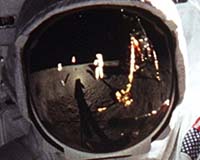 |
Washington (AFP) July 16, 2009 They have travelled further than any fashion item on Earth, surviving a hostile environment and extremes of heat and cold on a world far from ours. But now age is catching up with NASA spacesuits. "There is a lot of decay," admitted sadly Cathy Lewis, curator at the Smithsonian National Air and Space Museum, who is charge of looking after a dozen spacesuits worn on the Apollo missions. She even has under her care the suit worn by Neil Armstrong when he stepped out on the lunar surface on July 20, 1969, and made history as the first man to walk on the moon. But she agrees the passage of time has not been kind to these historic artifacts. "They don't do well because of the light and the humidity," she said. "They are made out of 21 layers of synthetic material. They are brittle," she said, adding that over time an ongoing chemical reaction between the different materials in the suits still encrusted with moon dust was taking its toll. Displayed behind glass at the museum since the late 1960s, the spacesuits have been withdrawn to be restored or at least to halt the ravages of decay as the United States prepares to mark the 40th anniversary of the moon landings. "Most of them are in restoration, but we can put them on display in a controlled environment for a short period of time," said museum curator Allan Needell. The custom-fit suits are made of a complex mixture of Teflon, polyvinylchloride and latex laced with tubing all aimed at allowing the astronauts to carry out their missions in the harshest of all environments. Today's suits have interlockable pieces so that none of the astronaut's skin is exposed to space, while multiple layers help protect the astronaut from extreme cold and heat. It is waterproof, fire-resistant and also made of the same material as bullet-proof vests. Lewis said the spacesuits made for the 12 moonwalkers were "made for very hard conditions, but for a very short period of time." She said the gloves were coming apart, the metallic layers were rusting and the rubber joints were deteriorating. The suits only spent a few days on the moon, where temperatures oscillate between minus 150 degrees Celsuis and 120 degrees Celusis. But they have spent the rest of the four decades in some of the nation's most humid places, like Houston, Texas, home to the Johnson Space Center; Florida, where the Kennedy Space Center is located; or the museum in Washington, known for its sticky summers. Lewis said that to preserve this part of history it is unlikely that the whole suits -- topped with a helmet with its visor blackened by a layer of gold to protect it from ultra-violet light -- will continue to be displayed. "We won't display them as a suit any more, but we hope to have the component on display in five years" such as gloves or boots if technicians manage to halt the decay she said. It depends on the funding, she added. The lunar lander is also undergoing a make-over. The four-footed module, which is seven meters high, is one of 12 constructed by NASA for the Apollo program which ended in 1972. The one on display never went into space but is identical to the others which were left on the moon when the astronauts returned to Earth. Along with the astronauts' footprints still imprinted on the lunar surface, the museum curators are anxious to conserve the site of the original moon landings, especially as NASA gears up for a return by 2020. "This is an actual artifact," said Needell of the landing site at the moon's Sea of Tranquility. "Let's hope the next ones won't put footprint over the old footprint at Tranquility Bay. I hope they will leave it alone," he said, worried that future generations of moonwalkers may try to remove pieces of history and sell them on eBay. "It's not abandoned property, it belongs to NASA," he stressed. Share This Article With Planet Earth
Related Links Mars News and Information at MarsDaily.com Lunar Dreams and more
 Wide Awake In The Sea Of Tranquillity
Wide Awake In The Sea Of TranquillityHuntsville AL (SPX) Jul 16, 2009 Neil Armstrong was supposed to be asleep. The moonwalking was done. The moon rocks were stowed away. His ship was ready for departure. In just a few hours, the Eagle's ascent module would blast off the Moon, something no ship had ever attempted before, and Neil needed his wits about him. He curled up on the Eagle's engine cover and closed his eyes. But he could not sleep. Neither cou ... read more |
|
| The content herein, unless otherwise known to be public domain, are Copyright 1995-2009 - SpaceDaily. AFP and UPI Wire Stories are copyright Agence France-Presse and United Press International. ESA Portal Reports are copyright European Space Agency. All NASA sourced material is public domain. Additional copyrights may apply in whole or part to other bona fide parties. Advertising does not imply endorsement,agreement or approval of any opinions, statements or information provided by SpaceDaily on any Web page published or hosted by SpaceDaily. Privacy Statement |